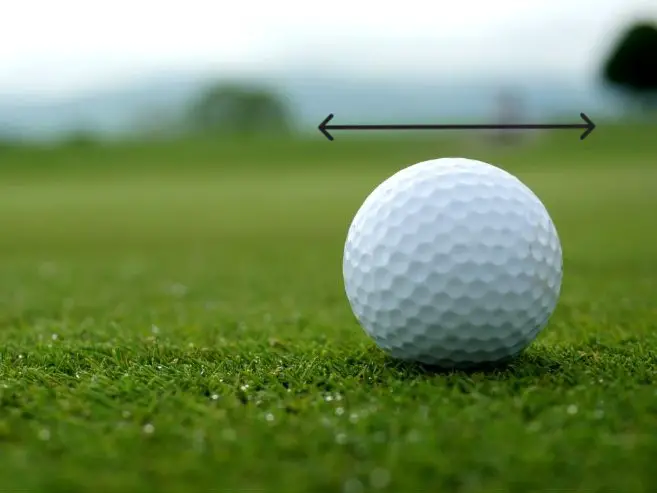Golf ball manufactures are required to follow strict guidelines when designing their golf balls. These specifications are important as they create consistent standard throughout the game of golf.
One key component of this standard is the diameter of a golf ball. Diameter refers to the transverse measurement of something, width, or thickness and is one of the most important components of a golf ball’s design.
In the article below, we will cover all you need to know about the diameter of a golf ball. Plus, we will cover other facts on golf ball specifications like weight, number of dimples, and much more. We have a lot to cover so let’s get started!
What Is The Standard Diameter Of A Golf Ball?
The diameter of a standard golf ball is 1.68 inches. This size is regulated by golf governing bodies like the United States Golf Association (USGA) and the Royal and Ancient Golf Club of St. Andrews (R&A).
Keep in mind that there can be slight variations due to manufacturing processes. However, the general diameter remains consistent to fit within the regulations for official golf play.
Have Golf Balls Always Been The Same Size?
The size of regulation golf balls has not always been the same. The modern standard size for golf balls, which is around 1.68 inches in diameter, was established by the United States Golf Association (USGA) and the Royal and Ancient Golf Club of St. Andrews (R&A) in the early 20th century.
Before that, golf balls came in various sizes and designs. Historically, golf balls were made from materials like wood, leather, and feathers.
These earlier golf balls had different sizes, and their performance characteristics varied significantly. For example, the “feathery” golf ball, which was popular in the 18th and 19th centuries, was made from leather and stuffed with feathers. These balls were handcrafted and had varying sizes and shapes.
It wasn’t until the 1990s that USGA and R&A introduced standardized specifications for golf balls, including size and weight, that the modern consistent size of golf balls was established. This standardization was intended to create a level playing field and ensure consistent performance for all players.
Are All Golf Balls The Same Size?
While most modern golf balls adhere to the standardized size of around 1.68 inches in diameter, there are some exceptions.
Golf ball manufacturers occasionally create specialty or novelty golf balls that deviate from the standard size for various reasons, such as marketing campaigns, unique designs, or specific purposes.
These non-standard golf balls may be larger or smaller than the typical size.
However, for official golf play and tournaments governed by organizations like the United States Golf Association (USGA) and the Royal and Ancient Golf Club of St. Andrews (R&A), the standard size of approximately 1.68 inches remains a requirement. This standardization ensures consistent performance and fairness across all players.
Are All Golf Balls The Same Weight?
Golf balls vary by weight. While there are general guidelines and standards for golf ball weight set by organizations like the United States Golf Association (USGA) and the Royal and Ancient Golf Club of St. Andrews (R&A), there can be variations in the weight of different golf ball models.
The USGA and R&A specify that the weight of a standard golf ball should not exceed 1.620 ounces (45.93 grams).
This weight limit is meant to ensure fairness and consistency in the game. Golf ball manufacturers work within this weight limit while also considering other factors like ball construction, materials used, and performance characteristics.
Different golf ball models may have varying designs, materials, and construction methods that can influence their weight.
For example, golf balls designed for distance might have different weight distributions compared to those designed for better control and feel around the green.
It’s important to note that while there is a weight limit for standard golf balls, there can be slight variations in weight among different balls while still adhering to the regulations.
Do All Golf Balls Have The Same Amount Of Dimples?
Not all golf balls have the same number of dimples. Dimples on a golf ball play a crucial role in its aerodynamics and flight characteristics.
The number, size, depth, and pattern of dimples can vary from one golf ball model to another, and even within the same brand’s range of golf balls.
Golf ball manufacturers conduct extensive research and testing to determine the optimal dimple design for their specific ball models.
The dimples help reduce aerodynamic drag, enhance lift, and provide stability during the ball’s flight.
Factors like the ball’s intended performance (distance, control, spin), the materials used in its construction, and the desired flight trajectory all influence the dimple design.
Different golf balls might have varying dimple counts, ranging from around 300 to 500 dimples or more.
The arrangement and pattern of the dimples on the ball’s surface can also vary, contributing to differences in aerodynamic properties.
So, while dimples are a common feature on golf balls, their number, size, and arrangement can differ significantly between different ball models, each tailored to meet specific performance goals.
Final Thoughts
In the article above, we explored the standard size and weight of golf balls. Golf’s governing bodies enforce these strict standards to ensure all golf balls are the same size. These standards ensure the game is fair for everyone.
The size of a golf ball is measured by its diameter, which is about 1.68 inches (that’s around the same as a coin). This measurement has a long history. A long time ago, golf balls were different sizes, but now they all must be the same. This rule makes the game more equal and fair.
So, when you’re out on the golf course, remember that even the smallest things – like the size of a golf ball – are part of what makes the game so interesting and exciting.
Hopefully, you liked this article and found it informative. Check out our other blog posts if you liked this one!


